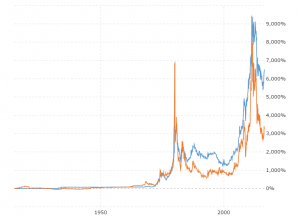Nickel and Dime Your Coin Collection – Part Two
Recently we wrote about collecting small change – the nickels and dimes that are rapidly disappearing from everyday use, with the growth of electronic methods for small purchases. These everyday items remain important for collectors though, and especially if you want to build an interesting collection, full of the history of American life, without investing in more valuable coins, or moving into precious metals.
Last time we looked at the nickel, first minted in 1866, and still with 1.5 billion being produced every year. This time let’s go up a level, and take a look at the dime. Like the nickel, there is a whole history behind the simple dime, and plenty of opportunities to build a collection of this simple coin, although early examples will be out of the reach of most collectors.
Dimes
In 1791 Alexander Hamilton, the first Secretary of the Treasury, created a set of six coins, one of which was 1/10th of a dollar. This was based on the idea of a decimal monetary system – a break with the old British system based on pounds divided into 20 shillings, with each shilling being divided into 12 pence. The revolutionaries were keen to replace the past in as many ways as possible. Although made mostly of silver, it was to contain only 1/10th of the silver in the dollar, so it had to be small and thin. It remains the smallest coin today, even though, since 1965, it has contained no silver. Since its introduction in 1796, there have been seven versions of the dime, each one interesting to collectors.
Disme 1792 – 1795
The first dime was called a ‘disme’ (perhaps based on the Latin word for ten, decem). These first dimes were never put into circulation, and since most of the existing ones are in copper, it is believed they were pattern coins, made just so that the look of the actual coin could be considered.
Draped Bust 1796–1807
This was the first circulation dime, made of 89.24% silver and 10.76% copper. It featured on the obverse Liberty based on a portrait by the prominent artist Gilbert Charles Stuart of the wife of Ann, the wife of William Bingham. The first reverse was an eagle surrounded by palm and olive branches, but later this became an eagle holding a shield, with 13 stars for the founding states above its head. There are several variations of this first dime.
Capped Bust 1809–1837
This design change introduced the now-familiar eagle holding arrows in one foot and olive branches in the other, suggesting strength and peace. Liberty on the obverse now wears a revolutionary cap, with the world ‘Liberty’ around its rim. Again, numerous variations were created, but the silver content was maintained.
Seated Liberty 1837–1891
In this dime the weight was adjusted so that the overall weights of the various coins at this time reflected their value – the dime weighed 1/10th of the dollar, and so on. Perhaps attempting to emulate the growing power of the British Empire during these years, the design of Liberty was modelled on the figure of Britannia used on British coins, showing her sitting on a rock. While Britannia held a sharp trident, Liberty holds a staff with a liberty cap on the end of it. The reverse features the words, ONE DIME, for the first time. Again, with this coin, there were numerous variations.
Barber 1892–1916
Named after the chief engraver of the time, Charles E. Barber, Liberty here is profile bust, wearing the Liberty cap.
Winged Liberty Head (Mercury) 1916–1945
This dime has the iconic Winged Liberty figure of Adolph A. Weinman, still used today on many special coins. There are numerous striking errors found in this dime, creating many valuable variations.
Roosevelt 1946–present
A coin to commemorate President Franklin D. Roosevelt was proposed when he died in 1945, and quickly designed and release the following year. The obverse features his bust, and the reverse a torch set in a bundle which resembles the one on the Winged Liberty, now discredited since it was a symbol adopted by the European Fascists. This design continues to today, although post-1965 the silver has been removed, replaced by copper and nickel.








